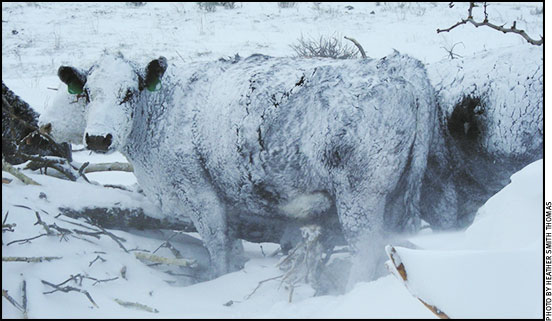
Minimize Cold Stress with Windbreaks and Feed
Cattle in good body condition can withstand severely cold temperatures — if they have a little help.
The two most important aspects of cold-weather care for cattle are adequate feed and shelter from wind. If cattle have adequate nutrition and are in good body condition, they have more insulation against cold and enough energy to keep warm.
“The part of the diet we focus on is energy during cold weather,” says Russ Daly, Extension veterinarian and associate professor at South Dakota State University. “Protein is really important, too, but energy for calves is crucial. Weaning-age calves need a high-energy diet that usually includes grain. Producers here in the Northern Plains also recognize that cattle increase their intake in response to the cold,” he says.
Daly says cattlemen have to be sure they are providing the additional feed cattle need. For animals with a functional rumen — older calves, adult cattle — having adequate protein to utilize the energy is important. Microbes in the rumen break down roughage in forage into useable energy, but they need protein to do this.
With the cold weather last winter, stockmen were able to help the animals maintain themselves, but that’s about it, Daly notes. Prolonged cold made it challenging to feed calves enough for weight gain. For mature animals, the best way to help them respond to cold stress is to feed enough energy and protein, especially as cows get into later gestation, to make sure the fetus isn’t shortchanged.
Windbreaks and bedding are important to prevent frostbitten ears or teats, or scrotal frostbite in bulls. Cows may suffer frostbitten teats before they calve, even without the moisture from the calf nursing, if they can’t get out of the wind. If the ends of the teats suffer severe frostbite damage, they may seal over with scar tissue and the newborn calf can’t start nursing the teat and can’t get any colostrum. Cows should be monitored for teat damage and possible scabbing and scarring.
“With dairy cows we have frost-guard products to put on the teats, but it’s more challenging to treat individual beef cows. If a producer notices problems with damaged teats, the tissue damage is already there, but might be able to salvage the teats if they get the cow in for treatment,” says Daly.
Frostbitten skin on the teats will generally heal, but may result in painful nursing during the healing process. The teats may become so sore the cow won’t let the calf suckle, so the producer must intervene to help the calf.
“Being aware of these possibilities is important when we have long stretches of really cold weather, especially if there is wind. Bedding and windbreaks can minimize the risks,” says Daly.
Scrotal frostbite is also a common problem after a cold, windy winter.
“Regardless of whether it was a bad winter or not, bulls should be checked for breeding soundness and semen-tested before the next breeding season. Bulls can often recover from scrotal frostbite, but it’s important to get them checked to see if they truly are recovered before they go out to breed cows. Sometimes bad-looking frostbite damage does not turn out to be a significant fertility problem, and some bulls that look like they wintered well may be the most adversely affected. You can’t just tell by looking at them. It pays to check,” he says.

Editor’s Note: Heather Smith Thomas is a cattlewoman and freelance writer from Salmon, Idaho.






